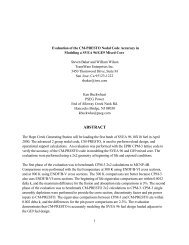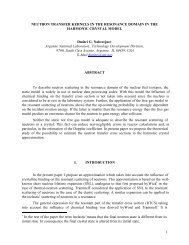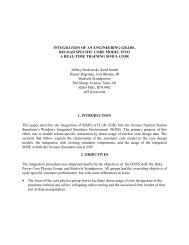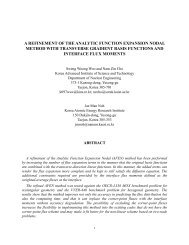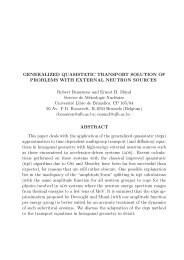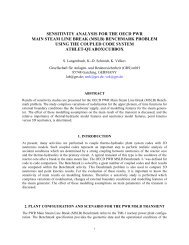Ellis
Ellis
Ellis
You also want an ePaper? Increase the reach of your titles
YUMPU automatically turns print PDFs into web optimized ePapers that Google loves.
The calculations for the VVER LTA studies were performed using the code HELIOS-1.4<br />
(developed by Studsvik Scandpower Inc.) with either the 89-group or 190-group nuclear data<br />
libraries based on ENDF/B-VI, release 2. The results presented for the PWR void reactivity<br />
effects were calculated for the most part using HELIOS-1.4 with the 89-group nuclear data<br />
library. Some additional and corroborating calculations were also performed using pin-cell<br />
models with the SAS2H and CSAS sequences from the SCALE-4.3 code system 6 similar to a<br />
recent ORNL benchmark study 7 , with the 238-group nuclear data library based on ENDF/B-V.<br />
3. RESULTS FOR VVER MOX LTA CALCULATIONS<br />
Figure 2 shows the behavior of keff as a function of fuel burnup for the full MOX LTA. Figure 3<br />
is a comparison of the peak-to-average relative pin power as a function of fuel burnup. The<br />
HELIOS and TVS-M pin power curves are similar in shape to about 30 MWd/kgHE (Megawatt<br />
days per kilogram of Heavy Elements) then the ORNL results indicate (seen as a kink) that a<br />
different pin becomes the one with the greatest relative pin power. Figure 4 shows that the<br />
relative agreement between the codes is quite good: keff and the peak pin power differences are<br />
1% for most of the burnup cycle.<br />
In Figure 5, results are presented from an optimization assessment for the graded Pu-content of<br />
the two-zone graded Pu-content MOX Island LTA design. Curves are plotted for peak relative<br />
pin powers versus the peripheral-zone Pu-content, for various Pu levels in the central zone.<br />
Interestingly, these curves are actually cusps. As the peripheral Pu content is decreased, the peak<br />
relative pin power (in the peripheral pins) drops gradually, until the peak relative pin power in<br />
the central region suddenly becomes greater than for any peripheral pin. Indications are the<br />
optimum fissile Pu grading (based on peak pin power ratio ≤ 1.2) is 3.8 wt% in the central zone,<br />
2.65 wt% in the peripheral zone, with the surrounding LEU being 3.7 wt% enriched.<br />
An extensive series of zero-power (isothermal) cases was completed for pertinent VVER MOX<br />
LTA designs and the reference LEU fuel assembly at various coolant soluble boron levels and<br />
reactor temperatures. The cases presented are one design of the two-zone graded Pu-content<br />
Island LTA, four different three-zone graded Pu-content full MOX LTA designs, and the<br />
reference UO2 assembly; all these are surrounded by fuel assemblies with 3.7 wt% enriched UO2.<br />
In Table I, a summary is presented of the reactivity effects calculated from keff determinations.<br />
The cases are identified by the zonal fuel content, from the center of the assembly to the<br />
periphery. As an example, the first case is “3.8/2.8/U-3.7 Island”: the central MOX zone<br />
contains fissile Pu at 3.8 wt% HE, the intermediate zone contains 2.8 wt% HE fissile Pu, and the<br />
outer region is UO2 at 3.7 wt% enrichment. The tabulated results are the reactivity effects for<br />
reactor temperature increase (including the coolant density decrease) for coolant with or without<br />
boron, and the reactivity worths of the boron concentration at different reactor temperatures. As<br />
is evident from the results tabulated in Table I, the agreement between the Russian TVS-M<br />
results and the ORNL HELIOS results is good over the full range of simulated fuel burnup.<br />
3



